Optical aids and other technologies provide access through magnification or speech output to students with low vision. Environmental factors, such as lighting, contrast, positioning, and clutter should also be considered when creating the optimal learning environment.
The use of technology should always begin with a comprehensive assessment, including a Functional Vision Assessment and a Learning Media Assessment. An Assistive Technology Assessment Summary may also be helpful at this stage. A Low Vision Specialist may also do an evaluation to determine whether optical devices may be appropriate.
Once an assessment has been completed, it is important to weigh additional considerations, such as:
- Where will the technology be used? Does it need to be portable? Will the student move from classroom to classroom?
- How will it be used?
- What training will the student need in order to use it?
Types of Technology for Learners with Low Vision
See also:
Additional Resources
Paths to Technology
Lots of practical ideas and resources for students with low vision using assistive technology
Low Vision
This section of the Tech Vision site has extensive information on a wide range of topics related to the use of technology for people with low vision. Some of the resources are available for free and others for purchase.
Overview of Assistive Technology for Families with a Visually Impaired Child





